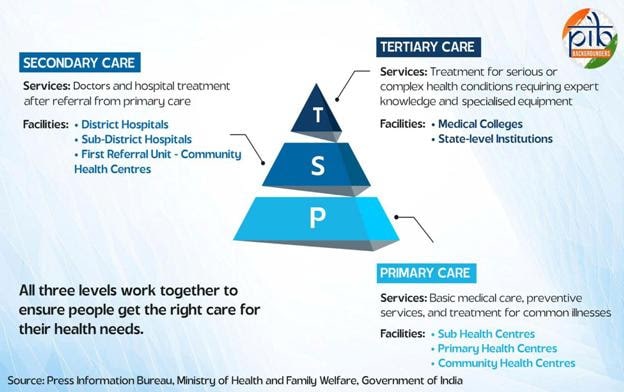




It is all about health care infrastructures at the grassroots. Truth? PM-ABHIM has allocated Rs. 64,180 crore (2021-26) to strengthen India's health infrastructure for pandemic preparedness and emergency response.
Launched in October 2021, it upgrades healthcare facilities from primary to tertiary levels, including AAMs, labs, critical care blocks, and surveillance systems nationwide
The mission advances universal health coverage goals and aligns with SDG-3 targets. During the COVID-19 pandemic, public health services—testing, case detection, surveillance, outbreak management, critical care, and others—were in high demand. The pandemic highlighted the need to reinforce India’s health system at the primary, secondary, and tertiary levels, to ensure effective responses to future outbreaks, emergencies, and evolving public health trends.
Launched on October 25, 2021, the Pradhan Mantri Ayushman Bharat Health Infrastructure Mission (PM-ABHIM) looks at infrastructure in health, research and surveillance. With an investment of Rs. 64,180 crore over the period 2021-26, the scheme works to expand and strengthen primary healthcare institutions, expand disease surveillance systems, support health research and build pandemic preparedness, while advancing India's universal health coverage goals, through the construction of Ayushman Arogya Mandirs, public health labs, and critical care facilities.
Policy Framework
PM-ABHIM strengthens India's health system by building on the National Health Policy 2017 and converging with the National Health Mission and the Ayushman Bharat scheme. They are major health initiatives of the Government of India, and while they are distinct programs, they are closely related and complementary in their goals.
Policy Foundation: National Health Policy 2017
The National Health Policy 2017 emphasises the importance of community health systems, including trained first responders working in collaboration with local self-government and community-based organisations, which are crucial for disaster preparedness and public health emergencies.
The National Health Mission—launched in 2005—establishes community-owned and decentralised health systems to provide accessible, affordable, and quality healthcare services to vulnerable populations. NHM has driven substantial progress in multiple areas, including maternal and child health, disease elimination, and healthcare infrastructure. The mission’s efforts have been integral to India's health improvements, particularly during the COVID-19 pandemic, and have played a vital role in ensuring more accessible and quality healthcare services across the country.
While the National Health Mission had established the foundation for community-based healthcare delivery, the 2017 National Health Policy reinforced these priorities and set the stage for further enhancement through the Ayushman Bharat scheme upon which PM-ABHIM now builds.
Ayushman Bharat Scheme
Launched in 2018, the Ayushman Bharat scheme builds on NHM's foundation to strengthen primary healthcare delivery through four key pillars:

Ayushman Bharat makes quality healthcare accessible on all three levels – primary, secondary and tertiary.
PM-ABHIM: Key Objectives and Components
Launched in 2021, the Pradhan Mantri–Ayushman Bharat Health Infrastructure Mission (PM-ABHIM) is one of India’s largest pan-national programmes aimed at developing a resilient, accessible, and self-reliant public health system.
The Mission focuses on strengthening health infrastructure from the grassroots to the district level through establishment and upgradation of Ayushman Arogya Mandirs (AAMs), Block Public Health Units, Integrated District Public Health Labs, and Critical Care Hospital Blocks in every district. These facilities aim to bridge service delivery gaps and ensure comprehensive primary, secondary, and critical care closer to communities.
PM-ABHIM also prioritises pandemic and disaster preparedness by expanding an IT-enabled, real-time disease surveillance network that integrates laboratories at block, district, regional, and national levels to detect, investigate, and prevent outbreaks effectively.
Additionally, it promotes health research and innovation, particularly on COVID-19 and other infectious diseases, by advancing the One Health approach, which recognises the interdependence of human, animal, and environmental health.
The Mission also aims to fill critical gaps in both urban and rural areas by creating Urban Health and Wellness Centres (AAM) in slum areas and converting Sub-Centres into AAMs.
Collectively, PM-ABHIM envisions a robust health ecosystem capable of withstanding future health emergencies while ensuring equitable and quality healthcare for all citizens.
Ending epidemics of communicable diseases by 2030, achieving universal health coverage and providing access to safe and affordable medicines and vaccines for all are some targets of the Sustainable Development Goal – 3. The Government of India supports the SDGs.

PM-ABHIM: Key Initiatives
The Pradhan Mantri–Ayushman Bharat Health Infrastructure Mission (PM-ABHIM) has made significant progress under its Centrally Sponsored Scheme (CSS) component, which focuses on strengthening health infrastructure at all levels during FY 2021–22 to FY 2025–26.
As per the latest data, 17,788 building-less Sub-Health Centres have been approved for upgradation into Ayushman Arogya Mandirs (AAMs), and 11,024 Urban AAMs (U-AAMs) are being set up to extend primary healthcare in slum and underserved urban areas. In addition, 3,382 Block Public Health Units (BPHUs) are being established to bolster block-level health administration and service delivery, while 730 Integrated Public Health Laboratories (IPHLs) are being developed—one in each district—to enhance diagnostic and surveillance capabilities. To strengthen tertiary care, 602 Critical Care Hospital Blocks (CCBs) are being set up in districts with populations exceeding five lakh.
Overall, administrative approvals worth ₹32,928.82 crorehave been accorded to States and Union Territories for these initiatives, covering 9,519 AAMs, 5,456 U-AAMs, 2,151 BPHUs, 744 IPHLs, and 621 CCBs. Together, these efforts mark a major step toward building a resilient, decentralised, and accessible public health network capable of delivering timely and quality healthcare across the country
Allocation of Resources
The financial year-wise break-up of allocation of resources under PM-ABHIM (in crore rupees) is as follows:
|
Component type |
2021-22 |
2022-23 |
2023-24 |
2024-25 |
2025-26 |
Total |
|
Centrally Sponsored Scheme (CSS) |
||||||
|
Central Share |
2412.91 |
3942.80 |
3361.67 |
4495.12 |
7914.89 |
22127.39 |
|
State Share |
1388.16 |
2276.34 |
1962.40 |
2655.64 |
4522.42 |
12804.95 |
|
15th FC share |
2026.98 |
2965.34 |
4000.04 |
4743.88 |
5536.19 |
19272.43 |
|
Sub-total of CSS Components |
5828.04 |
9184.48 |
9324.11 |
11894.64 |
17973.50 |
54204.78 |
|
CS components |
3327.92 |
1280.61 |
1691.69 |
1656.65 |
1382.89 |
9339.78 |
|
Grand Total |
9155.97 |
10465.09 |
11015.80 |
13551.30 |
19356.40 |
63544.56 |
|
Grand Total with M&E and PMC @1% of scheme |
|
|
64180 |
|||
Conclusion
Four years after its launch, PM-ABHIM has transformed India's health infrastructure, investing Rs. 64,180 crore to strengthen pandemic preparedness and emergency response capabilities.
By upgrading facilities from primary to tertiary care levels and enhancing surveillance systems, the scheme has built a more resilient healthcare system.
As India progresses toward Universal Health Coverage and SDG-3 targets, PM-ABHIM's community-focused approach—integrated with Ayushman Bharat initiatives and aligned with global health frameworks—ensures the nation is better prepared to protect public health in times of crisis.



